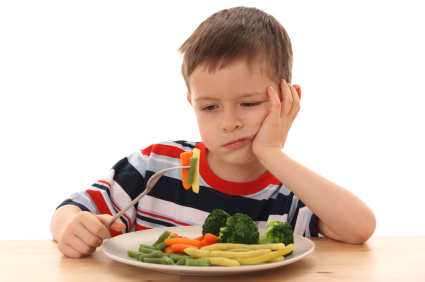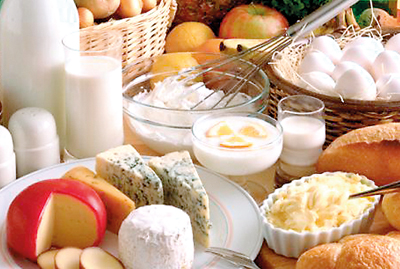Our kids eat less than half the vegetables they need, according to a recent report published by the Federal Interagency Forum on Child and Family Statistics. Some parents have taken to hiring outsiders to help them raise a veggie lover, but for those not wanting to outsource – or not having the money to do so – science offers some ways to make the peas and carrots go down easier.
Resistance often starts around 18 months of age: sealed lips, head turned away, food left untouched on the plate. Scientists have a term for when children won’t try new foods – food neophobia – and it makes sense from an evolutionary perspective. Peaking between ages 2 and 6, being standoffish from unknown foods protects a child, who is becoming less dependent, from eating substances that might be poisonous. Unfortunately, because there are so many kinds of vegetables, these are often the rejected foods.
How much your kid fears new foods may be highly heritable, say authors of a study of twins published last year. If you loathe trying new food, it appears, your child may, too. What’s more, many vegetables are bitter, and children are preprogrammed by nature to avoid bitter taste, since it may signal the presence of toxic compounds.
“Many parents don’t realize that it’s quite normal that most children will be fussy with vegetables,” says psychologist Gemma Mitchell of Britain’s Loughborough University.
So should you just give up and fry the potatoes, and opt for a once-a-day vitamin pill that will deliver the vitamin C, E and folate that picky eaters often miss in their diets?
Probably not. Nutritionists say vitamin pills are no replacement for vegetables and fruit. Veggies contain many important substances in addition to vitamins and minerals such as phytonutrients, which lower the risk of cancer and cardiovascular disease.
With all this in mind, here are some techniques, gleaned from the latest research, for dealing with food neophobia:
Offer vegetables with a glass of water
Don’t give up, even after many rejections. “The child doesn’t even have to eat it. Repeated exposure is all that is needed.”
Increase the portions. This may sound counterintuitive, but it turns out that if you pile up more veggies on your kid’s plate, more will get eaten. “What’s really effective is giving children big portions of vegetables at the start of a meal when they’re hungry. In our lab we’ve done this with raw carrots and with tomato soup. The bigger the portion was, the more the kids ate,” says Barbara Rolls, a professor of nutritional sciences at Penn State. So serve a salad before the mac and cheese. And you should probably keep the main portion small: An investigation published last year in the American Journal of Clinical Nutrition showed that the bigger the entree (the authors used mac and cheese in their experiments), the fewer fruits and vegetables get cleared off the plates.
Disguise the vegetables. “One of the most effective strategies we’ve found is the hidden-vegetable approach: putting pureed vegetables into dishes,” Rolls says. “Most kids don’t care what’s in their food as long as it tastes good. With baked goods like zucchini bread or pumpkin bread, we’ve found that kids actually prefer those with added vegetables because they are moister.” So put some grated vegetables into casseroles, pasta dishes or mac and cheese.
Build positive associations. “If a child is upset, many parents will say, ‘Oh, come here, have a cookie.’ Children are quick learners: Soon they start equating biscuits with comfort,” Mitchell says. But you can build a similar positive association with vegetables, offering up a carrot stick instead of a cookie.
Relax and have fun. Cut the veggies into creative shapes, mix as many colors on the plate as possible, allow the kids to get messy while eating. In other words: Let them have fun with food.
Finally, even if none of this works, relax – and wait. A 2010 study that followed a group of kids from age 2 to 11 found that picky eating declines as kids get older. By the time most are 6, only about 3 percent remain very fussy.
Source: Star news



 You know the saying, “An apple a day keeps the doctor away”? Turns out eating one apple isn’t enough. A new study suggests people who eat up to seven servings of fruit and vegetables a day can cut their risk of death by 42% – and that vegetables may be more important than fruit to your overall health.
You know the saying, “An apple a day keeps the doctor away”? Turns out eating one apple isn’t enough. A new study suggests people who eat up to seven servings of fruit and vegetables a day can cut their risk of death by 42% – and that vegetables may be more important than fruit to your overall health.
